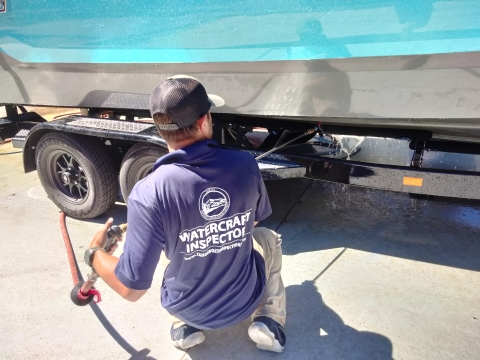Preventing the spread of aquatic invasive species invasive species
An invasive species is any plant or animal that has spread or been introduced into a new area where they are, or could, cause harm to the environment, economy, or human, animal, or plant health. Their unwelcome presence can destroy ecosystems and cost millions of dollars.
Learn more about invasive species can start with us.
In the United States, invasive species cause an estimated $123 billion dollars in damage including impacts to agriculture, public health, sport fishing, hydropower facilities, municipal water supplies, and the aquaculture industry.
In recognition of National Invasive Species week, the U.S. Fish and Wildlife Service would like to highlight in particular – aquatic invasive species.
What are Aquatic Invasive Species?
An aquatic invasive species is a freshwater or marine organism that has spread or been introduced beyond its native range and is either causing harm or has the potential to cause harm. This harm includes impacts to Native American Tribes.
One specific example of ongoing threats is the spread of aquatic invasives in Lake Tahoe, which is on ancestral lands, and of significant cultural importance to the Washoe Tribe (historic range of Lahontan cutthroat trout). Aquatic invasive species not only impact the Washoe Tribe ancestral lands but also their people and culture. Despite the many changes that have taken place in the Lake Tahoe Basin, the cultural importance of the Washoe People remains strong and deeply rooted in history and their traditions.
Along the southwest shore of Lake Tahoe, the Taylor-Tallac creeks and marshes are infested with approximately 17 acres of the invasive aquatic weed Eurasian watermilfoil.
Common invasive weeds, like the Eurasian watermilfoil, can significantly disrupt aquatic ecosystems, crowd out native species, and hinder the community’s ability to enjoy waterways.
With recent funding, there’s now potential to provide habitat for almost every native species in the Lake Tahoe Basin. In 2022, the Lake Tahoe Basin received a total of $3.4 million in year one funding invested by the Bipartisan Infrastructure Law to support these proven projects and expand collaborative efforts.
The Taylor-Tallac Aquatic Invasive Species Control Project is one of the highest priority areas for control and is a critical ecological resource for the Lake Tahoe Basin.
The Service remains committed to working with the Washoe Tribe, state, and federal partners to combat aquatic invasive species in Lake Tahoe. Other partners include the Tahoe Regional Planning Agency and the Washoe Environmental Protection Department which was established in 1998 and has been a key collaborator in ongoing restoration work.
Cherished for their picturesque beauty, the Taylor-Tallac creeks and marshes are a natural resource in the community. The Taylor-Tallac ecosystem is the largest functioning wetland in the Basin and is also an important recreation resource as well.
During National Invasive Species week, aquatic invasive species awareness and management is a top priority.
Here’s a few important things we all can do to ensure harmful species like aquatic invasive species do not spread into new areas:
- Clean your watercraft after each use.
- Clean outdoor recreation gear.
- Fish using native bait when possible.
- Volunteer at removal efforts.
- Don’t move firewood.
- Never release unwanted pets, aquarium fish, plants or live bait, and other exotic animals into the wild.
With awareness and collaboration, we can work towards protecting our waterways and preserving the natural beauty of Lake Tahoe for generations to come. Click here for Lake Tahoe Aquatic Invasive Species photos.






